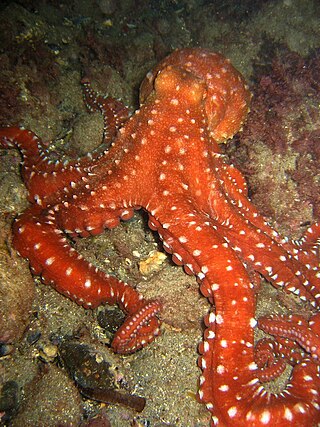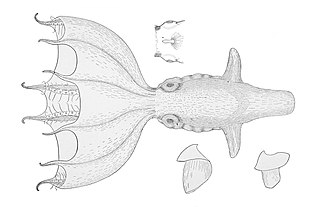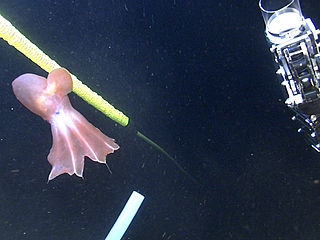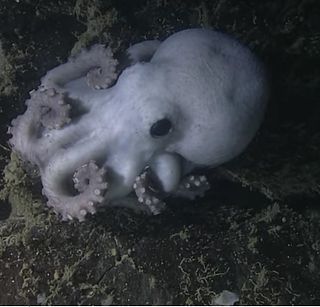
Grimpoteuthis is a genus of pelagic cirrate (finned) octopods known as the dumbo octopuses. The name "dumbo" originates from their resemblance to the title character of Disney's 1941 film Dumbo, having two prominent ear-like fins which extend from the mantle above each eye. There are 17 species recognized in the genus. Prey include crustaceans, bivalves, worms and copepods. The average life span of various Grimpoteuthis species is 3 to 5 years.

The Octopodidae comprise the family containing the majority of known octopus species.

Enteroctopus is an octopus genus whose members are sometimes known as giant octopuses.
Mark Douglas Norman is a scientist living in southern Australia. He works as a Chief Conservation Scientist with Parks Victoria.

Graneledone boreopacifica is an octopus in the family Megaleledonidae. It can be found in both the Pacific and the Atlantic Oceans.

Scaeurgus is a genus of octopuses in the family Octopodidae. The species of this genus are characterized by inhabiting the upper bathyal benthic zone from temperate and tropical latitudes in all major oceans.

Amphioctopus is a genus of octopuses comprising around 16 species.

Callistoctopus macropus, also known as the Atlantic white-spotted octopus, white-spotted octopus, grass octopus or grass scuttle, is a species of octopus found in shallow areas of the Mediterranean Sea, the warmer parts of the eastern and western Atlantic Ocean, the Caribbean Sea, and the Indo-Pacific region. This octopus feeds on small organisms which lurk among the branches of corals.

Stauroteuthis syrtensis, also known as the glowing sucker octopus or bioluminescent octopus, is a species of small pelagic octopus found at great depths in the north Atlantic Ocean. It is one of a very small number of octopuses to exhibit bioluminescence.

Cirroteuthis muelleri, also known as the big-finned jellyhead, was the first cirrate octopus species to be scientifically described. It is closely related to the genus Cirrothauma within the family Cirroteuthidae. At present the genus contains a single recognized species restricted to the Arctic Ocean and northern basins of the Atlantic and Pacific, but other species may be present in the southern hemisphere.

Callistoctopus ornatus is a tropical species of octopus native to the Indo-Pacific region. Other common names include white-striped octopus and night octopus, in reference to its nocturnal habits. It was previously known as Polypus ornatus. C. ornatus is edible and was recorded in a Hawaiian market in 1914 by S. S. Berry.
Graneledone yamana is a species of octopus in the genus Graneledone.

Bathypolypus arcticus, the North Atlantic octopus, deep sea octopus or spoonarm octopus is a small species of demersal octopus of the North Atlantic. It is usually found at depths of 200 to 600 m (660–1,970 ft) where the temperature is between 2 and 6 °C (36–43 °F).

Megaleledonidae is a family of octopuses in the superfamily Octopodoidea. It was formerly placed in the family Octopodidae sensu lato as the subfamily Megaleledoninae but more recent studies have raised this taxon as a valid family.
Microeledone mangoldi, the sickle-tooth pygmy octopus, is a species of octopus from the family Megaleledonidae. This species was described in 2004, the type specimen being a male which was collected from a depth of approximately 1,000 m (3,300 ft) near the Norfolk Ridge, in the southwest Pacific Ocean near New Caledonia. It is a very small octopus which has a single row of suckers, lacks an ink sac and has a radula with seven rows of teeth with the unique central tooth, called the rechidian tooth, being curved with a grooved tip. The remaining teeth are flat and plate like and so are also distinctive. The smooth creamy-pink body lacks any chromatophores. The specific name honours the Swiss malacologist and marine biologist Katharina Mangold-Wirz (1922-2003).
Galeoctopus lateralis, the sharkclub octopus, is a species of octopus, from the family Octopodidae. This species was described in 2004 from specimens collected at depths of 200–400 m in the southern and western Pacific Ocean. It is a small octopus in which the mature males have a distinctive ligula which superficially resembles a shark's jaw and head including teeth‐like lugs. Other distinguishing characteristics include a lateral mantle ridge, a skin sculpture which includes star-shaped papillae, and the females have oviducts with hare distally swollen.
Cryptoteuthis brevibracchiata, the short-arm flapjack octopod, is a deepwater species of octopod. It is the only species in the monotypic genus Cryptoteuthis one of the cirrate octopuses of the family Grimpoteuthidae, the umbrella octopuses. It is known from a single specimen which was collected in the northeastern Atlantic Ocean. It has characteristics which are shared with two other genera, Opisthoteuthis and Grimpoteuthis, but is sufficiently distinctive from either of these to warrant the erection of a new genus.

Opisthoteuthis agassizii is a lesser-known, deep-sea octopus first described in 1883 by Addison E. Verrill.
Opisthoteuthis dongshaensis is a species of octopus located in the South China Sea.
Frederick George "Eric" Hochberg (1941–2023) was a marine biologist specializing in the study of cephalopods and their parasites.












